Porcupinefish
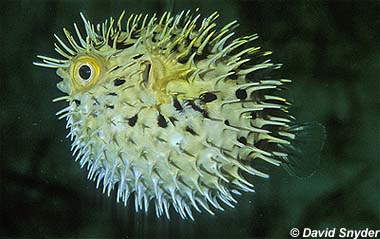
Diodon hystrix
This porcupinefish looks similar to its relative, the balloonfish, but its body is uniformly grayish-tan, speckled evenly with black spots, with a white belly. The spines all over its body are modified scales, and when it’s threatened, it intakes water, puffing up and making the spikes stand out.
It prefers living alone near reefs, caves or ledges, hunting crustaceans and molusks at night. It can grow up to 36 inches, but is usually found as an adult at around 16 inches. Because it secretes a toxin, it’s not considered a food catch, but some are caught for the aquarium trade.
Order – Tetraodontiformes
Family – Diodontidae
Genus – Diodon
Species – hystrix
Common Names
Porcupinefish, ajargo, hedgehog, hedgehog fish, porcupine fish, sharptail mola, spot-fin porcupinefish, spotted porcupine, spotted porcupine fish, spotted porcupinefish, adjidjan, baiacu-de-espinho, bankocho, batana, batea, bunju miiba, buntal landak, buntel duren, buteteng laot, crum, diodon jezyk, dot, guanabana, katu peyttheya, kumme, kuuxiny, mullu peytthai, nezumifugu, peixe lua, penvis, peste arici, pez eriso, pez erizo del punteado, porco-esphinho, porkspim, puerco espin, sokisoki, tagotongan, taius-wushuga, tamborillo, tauta, tautu, totara, and uruhakau.
Importance to Humans
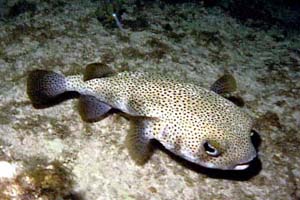
The porcupinefish is a shy creature and will retreat if approached by divers. They secrete a toxic skin substance so are usually considered poisonous, although they have been known to be eaten in Hawaii and Tahiti. In the orient the dried, inflated bodies are sold as tourist novelties. And on some Pacific islands, the dried skins were used in the past as war helmets. Porcupinefish are also collected for private and public show aquariums. They are not normally caught for human consumption.
Conservation
This fish is not listed as endangered or vulnerable with the World Conservation Union (IUCN). The IUCN is a global union of states, governmental agencies, and non-governmental organizations in a partnership that assesses the conservation status of species.
> Check the status of the porcupinefish at the IUCN website.
Geographical Distribution
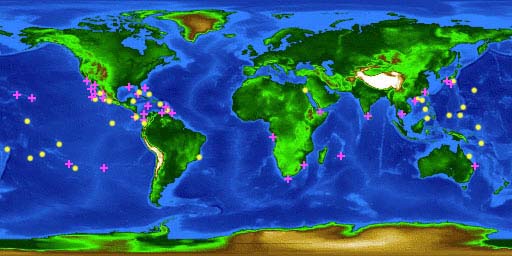
The porcupinefish and balloonfish are widely distributed species, found circumtropically and often in temperate marine environments. The porcupinefish is the only member of its genus to be found in the Mediterranean Sea. In the eastern Pacific, it ranges from San Diego, California (US) to Chile including the Galapagos Islands (Ecuador). It is also found in the western Atlantic from Massachusetts (US) to the northern Gulf of Mexico south to Brazil. It also occurs in Bermuda. In the eastern Atlantic it is generally found between 30°N and 23°S.
Habitat
Adults generally linger inshore, around areas that offer shelter, such as caves, shipwrecks, reefs, and ledges. They are nocturnal and solitary creatures, commonly residing in holes and crevices within the reef complex. Juveniles are pelagic until reaching 8 inches (20cm) in length, after which they become benthic.
Biology
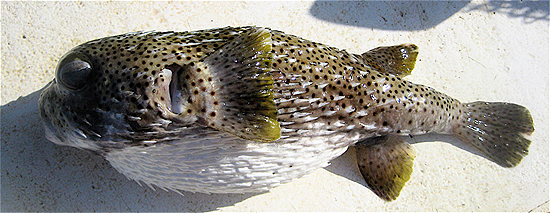
Distinctive Features
The porcupinefish (Diodon hystrix) gets its name from the numerous long spines located all over the head and body. There are approximately 20 spines in a row between the snout and dorsal fin. It is a member of the puffer fish family Diodontidae. These fish are capable of expanding their body size by taking in water and inflating when threatened. The spines of the porcupinefish only stick out when the fish is inflated, at all other times the spines lay flat against the body. When fully inflated, the fish has a formidable presence that makes predators think twice about taking a bite.
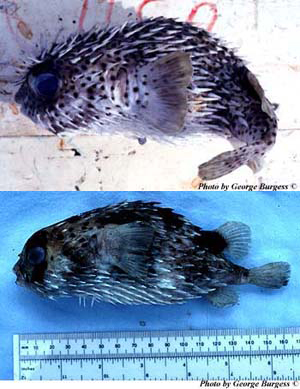
Coloration
Body is grayish-tan with small black spots but lacking large dark blotches. The underside is white surrounded by a dusky ring. The porcupinefish closely resembles its relative the balloonfish (Diodon holocanthus) which also is covered in spines. They can be distinguished from each other by noting the different body shapes and the different patterns of spots on the skin. The porcupinefish is larger than the balloonfish, with a wider head, and has small black spots that cover the body and fins. The skin of the balloonfish is dominated by larger spots or dark blotches that occur only on the body, not on the fins. For further information see key to the species of Diodon.
Size
Adults can reach lengths up to 36 inches (91 cm), making them the largest spiny puffer species.
Dentition
The teeth are fused together into a single unit, creating a strong, beak-like mouth capable of cracking the shells of snails, sea urchins, and hermit crabs.
Food Habits
They are nocturnal predators, with strong jaws for feeding on snails, hermit crabs, and sea urchins. Just as some birds are able to crack open nuts with their strong beak, the porcupinefish can crack open the external skeleton of a sea urchin with its strong beak-like mouth.
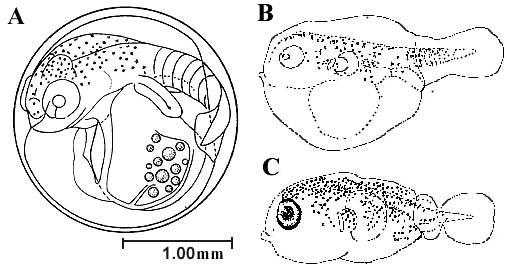
Reproduction
Its wide distribution may be attributed to the pelagic, or open ocean, stage of the eggs and larvae. The eggs are spherical, drift with the current, and hatch after about five days. Early planktonic larvae have large amounts of yolk still present, lack a functional mouth, and have not developed full eye pigmentation. It takes a few days for the yolk to be used up and for the body to develop to where the larvae truly resemble fish.
Pelagic juveniles are often associated with large clumps of floating seaweeds called sargassum, and are often consumed by dolphin (mahi mahi) and billfishes. The duration of this pelagic stage is unknown, but at some point the juveniles travel to shallower waters to become adults.
Predators
The porcupinefish is eaten by large carnivorous fishes including the dolphinfish, wahoo, and sharks.
Taxonomy
The porcupinefish was first described in 1758 by Linnaeus as Diodon hystrix. The genus Diodon is derived from the Greek words “di” = two and “odous” = teeth while the species name hystrix is translated from Greek as porcupine. Synonyms include Diodon brachiatus Bloch and Schneider 1801, Diodon punctatus Cuvier 1818, Diodon spinosissimus Cuvier 1818, Diodon nudifrons Jenkins 1903, Diodon armillatus Whitley 1933, and Diodon totara Curtiss 1938.
Prepared by: Casey Patton